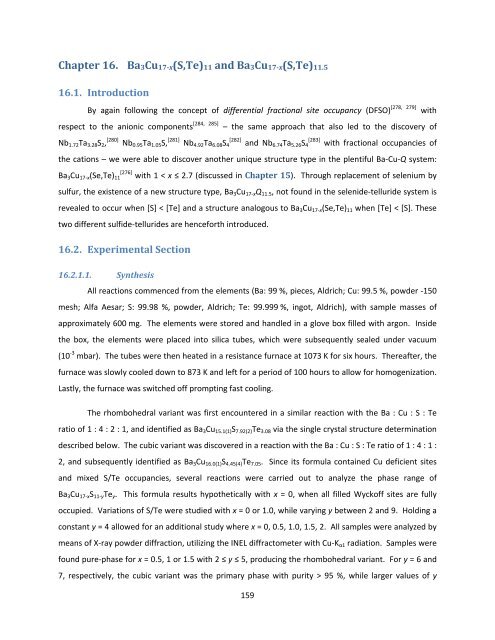Exploration and Optimization of Tellurium‐Based Thermoelectrics
Exploration and Optimization of Tellurium‐Based Thermoelectrics
Exploration and Optimization of Tellurium‐Based Thermoelectrics
You also want an ePaper? Increase the reach of your titles
YUMPU automatically turns print PDFs into web optimized ePapers that Google loves.
Chapter 16. Ba3Cu17‐x(S,Te)11 <strong>and</strong> Ba3Cu17‐x(S,Te)11.5<br />
16.1. Introduction<br />
By again following the concept <strong>of</strong> differential fractional site occupancy (DFSO) [278, 279] with<br />
respect to the anionic components [284, 285] – the same approach that also led to the discovery <strong>of</strong><br />
Nb1.72Ta3.28S2, [280] Nb0.95Ta1.05S, [281] Nb4.92Ta6.08S4 [282] <strong>and</strong> Nb6.74Ta5.26S4 [283] with fractional occupancies <strong>of</strong><br />
the cations – we were able to discover another unique structure type in the plentiful Ba‐Cu‐Q system:<br />
Ba3Cu17‐x(Se,Te)11 [276] with 1 < x ≤ 2.7 (discussed in Chapter 15). Through replacement <strong>of</strong> selenium by<br />
sulfur, the existence <strong>of</strong> a new structure type, Ba3Cu17‐xQ11.5, not found in the selenide‐telluride system is<br />
revealed to occur when [S] < [Te] <strong>and</strong> a structure analogous to Ba3Cu17‐x(Se,Te)11 when [Te] < [S]. These<br />
two different sulfide‐tellurides are henceforth introduced.<br />
16.2. Experimental Section<br />
16.2.1.1. Synthesis<br />
All reactions commenced from the elements (Ba: 99 %, pieces, Aldrich; Cu: 99.5 %, powder ‐150<br />
mesh; Alfa Aesar; S: 99.98 %, powder, Aldrich; Te: 99.999 %, ingot, Aldrich), with sample masses <strong>of</strong><br />
approximately 600 mg. The elements were stored <strong>and</strong> h<strong>and</strong>led in a glove box filled with argon. Inside<br />
the box, the elements were placed into silica tubes, which were subsequently sealed under vacuum<br />
(10 ‐3 mbar). The tubes were then heated in a resistance furnace at 1073 K for six hours. Thereafter, the<br />
furnace was slowly cooled down to 873 K <strong>and</strong> left for a period <strong>of</strong> 100 hours to allow for homogenization.<br />
Lastly, the furnace was switched <strong>of</strong>f prompting fast cooling.<br />
The rhombohedral variant was first encountered in a similar reaction with the Ba : Cu : S : Te<br />
ratio <strong>of</strong> 1 : 4 : 2 : 1, <strong>and</strong> identified as Ba3Cu15.1(1)S7.92(2)Te3.08 via the single crystal structure determination<br />
described below. The cubic variant was discovered in a reaction with the Ba : Cu : S : Te ratio <strong>of</strong> 1 : 4 : 1 :<br />
2, <strong>and</strong> subsequently identified as Ba3Cu16.0(1)S4.45(4)Te7.05. Since its formula contained Cu deficient sites<br />
<strong>and</strong> mixed S/Te occupancies, several reactions were carried out to analyze the phase range <strong>of</strong><br />
Ba3Cu17‐xS11‐yTey. This formula results hypothetically with x = 0, when all filled Wyck<strong>of</strong>f sites are fully<br />
occupied. Variations <strong>of</strong> S/Te were studied with x = 0 or 1.0, while varying y between 2 <strong>and</strong> 9. Holding a<br />
constant y = 4 allowed for an additional study where x = 0, 0.5, 1.0, 1.5, 2. All samples were analyzed by<br />
means <strong>of</strong> X‐ray powder diffraction, utilizing the INEL diffractometer with Cu‐Kα1 radiation. Samples were<br />
found pure‐phase for x = 0.5, 1 or 1.5 with 2 ≤ y ≤ 5, producing the rhombohedral variant. For y = 6 <strong>and</strong><br />
7, respectively, the cubic variant was the primary phase with purity > 95 %, while larger values <strong>of</strong> y<br />
159
















